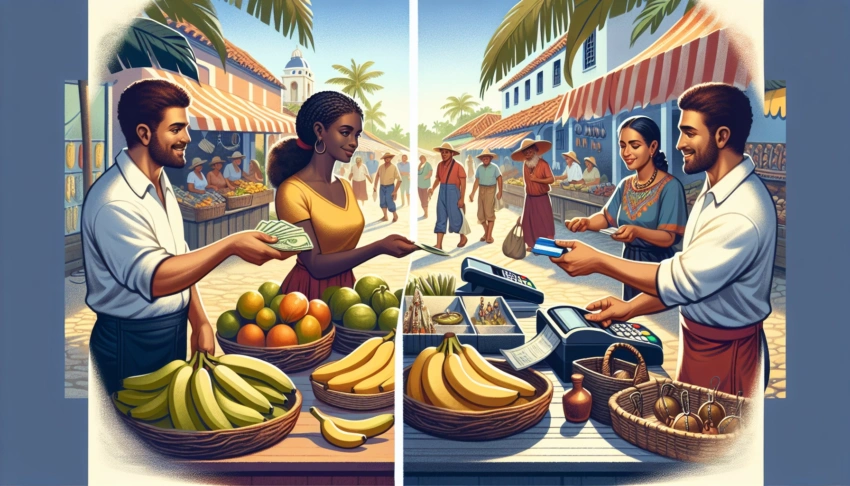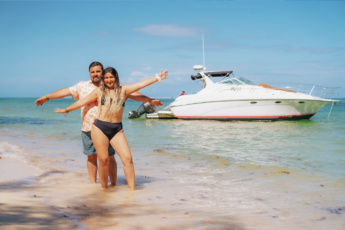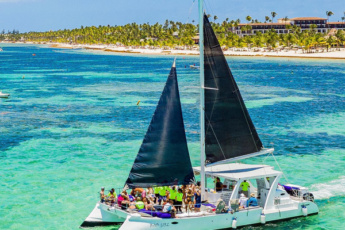Cash vs. Card: How to Handle Money Safely in the Dominican Republic
Understanding Currency in the Dominican Republic

Cash vs. Card: How to Handle Money Safely in the Dominican Republic
Navigating the vibrant and captivating Dominican Republic can be an exhilarating experience, but understanding the local currency is crucial for a smooth journey. This section provides a comprehensive guide to the Dominican peso, exchange rates, and safe places to exchange your money, ensuring you can explore with confidence.
1. The Dominican Peso: An Overview
The official currency of the Dominican Republic is the Dominican peso (DOP), which is symbolized by “$” or “RD$” to distinguish it from other currencies. As a traveler, becoming familiar with the peso’s denominations is essential to avoid confusion during transactions. The peso comes in both coins and banknotes, with coins available in 1, 5, 10, and 25 pesos, and banknotes in 50, 100, 200, 500, 1,000, and 2,000 pesos. Each denomination features prominent figures and landmarks that reflect the country’s rich cultural heritage.
Dominican Peso Denominations
| Type | Denominations | Symbol | Description |
|---|---|---|---|
| Coins | 1, 5, 10, 25 pesos | RD$ | Commonly used for small purchases |
| Banknotes | 50, 100, 200, 500, 1,000, 2,000 pesos | RD$ | Used for larger transactions and everyday expenses |
Understanding these denominations will not only enhance your shopping experience but also help you manage your budget effectively. For a deeper dive into the captivating designs and historical significance of each bill, consider visiting the local museums and cultural centers.
2. Exchange Rates and Conversion Tips
Before embarking on your Dominican adventure, it’s crucial to acquaint yourself with the current exchange rates as they can fluctuate frequently. The rate can vary depending on where you exchange your money, so it’s wise to keep an eye on reliable sources such as banks or financial news websites. As of the latest update, 1 USD is approximately 56-58 DOP, but it’s always best to verify before making any conversions.
To make your life easier, consider using currency conversion apps or online calculators, which provide real-time rates and help you make quick calculations while shopping or dining. Some popular tools include XE Currency Converter and OANDA.
3. Where to Exchange Money Safely
Ensuring your money is exchanged safely and securely is paramount. The safest options for exchanging your currency include banks, ATMs, and authorized exchange centers. Banks such as Banco Popular and BanReservas are reputable institutions where you can exchange money with confidence. They offer competitive rates and the assurance of security.
While ATMs are widely available in cities and tourist areas, it’s essential to use those located within bank branches or shopping centers to minimize the risk of fraud. Additionally, authorized exchange centers in airports and hotels can be convenient, though they might offer slightly less favorable rates. Always compare different sources and avoid street vendors, as they can be unreliable.
Remember, understanding the local currency and knowing where to exchange it safely can enhance your travel experience, allowing you to focus on the incredible sights and sounds the Dominican Republic has to offer.
Using Cash in the Dominican Republic
When it comes to managing your finances during a tropical getaway in the Dominican Republic, cash is often king. However, wielding those pesos wisely requires a bit of tactical finesse. Understanding the pros and cons of using cash, coupled with some savvy safety tips, can ensure that your experience is as smooth as a piña colada on a sunny beach.
1. Pros and Cons of Using Cash
Cash can be a double-edged sword when traveling. On one hand, cash is universally accepted, even in remote areas where card readers might not be available. It also helps you stick to a budget, as you’re physically aware of how much you’re spending. On the flip side, carrying large sums is risky if you misplace it or, heaven forbid, if it gets stolen. Moreover, cash transactions lack the security and record-keeping that cards provide.
Cash Usage: Advantages vs. Disadvantages
| Advantage | Disadvantage | Example |
|---|---|---|
| Widely Accepted | Risk of Loss/Theft | Local markets |
| Budget Control | No Transaction Records | Street vendors |
| No Fees | No Security Features | Small eateries |
2. Tips for Handling Cash Safely
To make the most of your cash transactions while ensuring your money stays safe, follow these tips:
- Divide and Conquer: Don’t keep all your cash in one place. Spread it across different pockets or bags to minimize potential loss.
- Use a Money Belt: Wearing a money belt under your clothes can keep your cash secure and discreet.
- Stay Low-Key: Avoid flashing large bills in public places. Instead, prepare small denominations for everyday transactions.
- Hotel Safes Are Your Friend: Store extra cash in your hotel safe and only carry what you need for the day.
These common-sense safety measures can significantly reduce the risk of losing your cash during your journey.
3. Recognizing and Avoiding Counterfeit Currency
Counterfeit currency is a concern in any country, and the Dominican Republic is no exception. Familiarizing yourself with the look and feel of authentic Dominican pesos is crucial. Genuine bills have distinctive textures, security threads, and watermarks that are hard to replicate. When in doubt, feel the raised print and look for inconsistencies in the hologram or color-shifting ink.
If you suspect a bill is counterfeit, politely refuse it and ask for a different note. Remember, it’s your right as a consumer to ensure the money you receive is legitimate. In the unfortunate event that you come across counterfeit currency, report it to local authorities as soon as possible for further action.
Our Best Tours in the Dominican Republic
While you’re here, why not immerse yourself in the vibrant culture and breathtaking landscapes of the Dominican Republic? We offer exclusive tours that showcase the best the island has to offer, from thrilling adventures to serene escapes. Check out some of our top recommendations below and book your unforgettable experience today!

Saona Island Excursion - Caribbean Paradise
from $75 Read more
Swimming with Dolphins in Punta Cana - Top Adventure 2025 (50 minutes)
from $149 Read moreThe Role of Credit and Debit Cards
In the vibrant landscape of the Dominican Republic, the convenience of credit and debit cards can be a traveler’s best friend. Offering a seamless way to manage finances, these cards provide a sense of security and ease that cash sometimes lacks.
1. Benefits of Using Cards
Credit and debit cards offer a slew of advantages over carrying hefty cash. For starters, cards are universally accepted in most urban areas, especially in places like Santo Domingo and Punta Cana. They reduce the need to carry large amounts of cash, minimizing the risk of theft or loss. Moreover, many cards provide attractive rewards, such as travel miles or cashback, which can be a delightful bonus for frequent travelers.
Additionally, using a card can help with budgeting. You can easily track your spending through your bank’s mobile app or online banking portal, keeping tabs on your expenses without the manual hassle of counting cash. Cards also offer a layer of fraud protection; most banks have robust systems in place to detect abnormal activities and prevent unauthorized transactions.
2. Risks and Fees Associated with Card Use
Despite their advantages, using cards comes with its own set of challenges. Foreign transaction fees can surprise you if you’re not careful. These fees are typically around 1% to 3% of each transaction and can quickly add up over the course of a trip. It’s wise to check with your bank about these fees before you travel.
Fraud is another concern. Although banks offer protection, being vigilant is crucial. Skimming devices at ATMs or dishonest vendors can lead to unauthorized charges. Additionally, some smaller establishments may not accept cards or might impose a minimum spending limit, which can be inconvenient.
Comparing Card Fees and Protections
| Card Type | Typical Foreign Transaction Fee | Fraud Protection | Acceptance Rate |
|---|---|---|---|
| Visa | 1% – 3% | High | Very High |
| Mastercard | 1% – 3% | High | Very High |
| American Express | 2% – 3% | High | Moderate |
3. Best Practices for Card Safety
To keep your card information safe and secure, consider these best practices. First, inform your bank about your travel plans. This will prevent your account from being flagged for unusual activity. Also, use ATMs located within banks rather than standalone machines, which are more susceptible to tampering.
Enable transaction alerts on your phone so you’ll receive notifications for every purchase, allowing you to spot unauthorized transactions quickly. When dining out or shopping, keep an eye on your card at all times. If you must use public Wi-Fi, ensure it’s secure, or better yet, use a VPN to protect your data.
With these insights, using credit and debit cards in the Dominican Republic can be both safe and rewarding. Embrace the convenience and security they offer—just remember to stay vigilant and informed.
Digital Payment Options and Mobile Wallets
In today’s digital age, managing your finances through mobile devices is not just convenient but also increasingly popular, especially when traveling. The Dominican Republic is no exception, offering a variety of digital payment options that can make your trip smoother and more secure.
1. Popular Digital Payment Methods
In the Dominican Republic, several digital payment methods have gained traction, allowing visitors to manage their expenses without needing cash. PayPal is widely used, providing a familiar interface for many travelers. Visa Checkout and Masterpass offer robust platforms for secure payments, accepted at many retailers. Moreover, Pago Móvil is a local favorite, facilitating quick transactions between individuals and businesses.
Another noteworthy service is Orange Money, which is especially popular in urban areas. This service allows users to link their bank accounts to their mobile numbers for seamless transactions. Additionally, Apple Pay and Google Pay are increasingly accepted in larger cities and tourist hotspots, providing contactless payment solutions for tech-savvy travelers.
2. Acceptance of Mobile Wallets
Mobile wallets are becoming more prevalent in the Dominican Republic, with acceptance growing in various sectors. Major supermarkets, chain restaurants, and even some local boutiques now accept mobile payments, which is a testament to the country’s move towards digital finance. However, the acceptance of mobile wallets can vary significantly in rural areas, where cash remains king.
For travelers, it’s advisable to check with individual vendors about their acceptance of mobile wallets. In tourist areas like Punta Cana and Santo Domingo, the likelihood of being able to use digital payment methods is higher, giving you the freedom to enjoy your trip without the hassle of handling cash.
Our Best Tours in Punta Cana
Planning to explore the rich culture and beautiful landscapes of the Dominican Republic? Our curated tours offer unique experiences that can be conveniently booked using digital payment methods. Dive into an adventure with the confidence of secure transactions.

Punta Cana Private Boat Trip at the Best Price - 3-Hour Exclusive Tour with Snorkeling (from Jellyfish to Cabeza de Toro)
from $590 Read more
Power Cruise – Punta Cana Party Experience on the Bad Girl Catamaran
from $65 Read more3. How to Set Up and Use Mobile Wallets
Setting up a mobile wallet is straightforward, whether you’re using Apple Pay, Google Pay, or a local service like Orange Money. Here’s a quick guide to get you started:
- Download the app from your device’s app store.
- Register with your mobile number and email address.
- Link your bank account or credit card to the app.
- For enhanced security, set up a strong password and enable two-factor authentication.
- Test the wallet with a small transaction to ensure it’s working correctly.
Using mobile wallets not only simplifies transactions but also adds a layer of security, as you don’t have to carry large amounts of cash. With these tools, you can focus more on enjoying your trip and less on worrying about financial logistics.
Cultural Considerations and Local Etiquette
Navigating the cultural landscape of money handling in the Dominican Republic can be as enriching as the vibrant culture itself. Whether you’re strolling through a bustling market or dining at a local eatery, understanding the local monetary etiquette will enhance your travel experience.
1. Cash Usage in Local Markets and Small Businesses
In the colorful tapestry of the Dominican Republic’s local markets, cash remains king. From the aromatic stalls of fresh produce in Mercado Modelo to quaint beachfront kiosks, small businesses often prefer cash transactions. This preference stems from several practical reasons, including avoiding card transaction fees and the convenience of immediate cash flow.
- Carry small denominations: Vendors may not have enough change for large bills, so it’s wise to have smaller denominations on hand.
- Embrace the art of bargaining: Haggling is a common practice in markets. It’s a friendly game of negotiation, where having cash can sometimes score you a better deal.
- Stay vigilant: When handling cash in crowded settings, always be aware of your surroundings to avoid pickpocketing.
2. Tipping Practices in the Dominican Republic
Tipping is an integral part of the service culture in the Dominican Republic, reflecting appreciation for good service. However, the norms can vary depending on the setting.
- Restaurants: A 10% service charge is often included in the bill, but adding an extra 5-10% for excellent service is customary.
- Hotels: Tip bellhops $1-2 per bag and housekeepers a few dollars each day of your stay.
- Tour Guides: For guided tours, a tip of 10-15% of the tour cost is appreciated.
While tipping is appreciated, it’s not obligatory. Always assess the service quality and tip accordingly.
3. Communicating About Money in Spanish
Having a few key Spanish phrases up your sleeve can make financial transactions smoother and more enjoyable. Here are some essential phrases:
- ¿Cuánto cuesta? – How much does it cost?
- ¿Acepta tarjetas de crédito? – Do you accept credit cards?
- ¿Puede darme el cambio? – Can you give me change?
- Necesito un recibo, por favor. – I need a receipt, please.
Integrating these phrases into your interactions not only aids in communication but also shows respect for the local culture, often resulting in warmer, more personable exchanges.
Understanding these cultural nuances not only facilitates smoother transactions but also enriches your interaction with the vibrant Dominican culture. Embrace the local customs, and you’ll find that navigating the financial landscape becomes a delightful part of your adventure.
Frequently Asked Questions
Navigating monetary transactions in a foreign country can be tricky. Here, we address common questions about handling money safely in the Dominican Republic to ensure your trip is smooth and secure.
1. Is it better to use cash or card in the Dominican Republic?
Whether to use cash or card depends largely on the situation. In bustling city areas, credit cards are widely accepted and offer convenience and security. However, when venturing into rural areas or local markets, cash is king. Consider carrying a mix of both for maximum flexibility. Remember, when using cards, you avoid the hassle of currency exchange but may encounter foreign transaction fees.
2. Are ATMs widely available in the Dominican Republic?
ATMs are generally available in urban areas, major tourist destinations, and airports. However, availability in rural areas can be limited. It’s wise to withdraw enough cash before heading to remote locations. Note that ATMs may charge additional fees for foreign cards, so plan your withdrawals accordingly to minimize costs.
3. What should I do if my card is lost or stolen?
If your card goes missing, the first step is to contact your bank immediately to block the card and prevent unauthorized transactions. Most banks offer 24/7 customer service for such emergencies. It’s also a good idea to have a backup card stored separately from your primary card. Consider setting up travel alerts with your bank before your trip to streamline assistance if issues arise.
4. Can I use US dollars in the Dominican Republic?
US dollars are accepted in many tourist areas, but it’s not always guaranteed. Local shops, taxis, and smaller vendors might prefer Dominican pesos. It’s advisable to carry some local currency for smaller purchases and transactions away from tourist hotspots. However, using US dollars can be convenient for paying for tours and services that cater to international visitors.
5. What are the typical fees for using a card internationally?
Using a card abroad often comes with foreign transaction fees, typically around 1-3% of each transaction. Some banks may also charge ATM withdrawal fees. It’s wise to check with your bank to understand their fee structure and explore cards that offer no foreign transaction fees to save on costs during your travels.
For travelers looking to explore the vibrant culture and stunning landscapes of the Dominican Republic, understanding how to handle money is crucial. With the right mix of cash and card, you can enjoy a hassle-free adventure.
6. How can I avoid credit card fraud while traveling?
To minimize the risk of credit card fraud, use your card only at trusted merchants and ATMs. Avoid sharing your card details over public Wi-Fi. Regularly check your bank statements for unauthorized charges and report them immediately. Enabling two-factor authentication and setting up transaction alerts can provide additional layers of security.
7. Are contactless payments widely accepted?
Contactless payments are gaining traction but are not universally accepted across the Dominican Republic. Larger retailers and restaurants in urban areas are more likely to accept contactless methods. It’s advisable to carry a backup payment method as not all establishments have adopted this technology.
8. What is the maximum amount of cash I can carry legally?
Travelers can legally carry up to $10,000 USD or its equivalent in other currencies without declaring it at customs. Exceeding this amount requires declaration to avoid penalties. It’s always best to carry only what you need to stay within these limits and reduce the risk of loss or theft.
9. How do I report counterfeit currency?
If you suspect you have received counterfeit currency, report it to the nearest bank or police station. Avoid passing the bill to others. The local authorities will guide you on the next steps. Keeping receipts from currency exchanges can serve as proof of legitimate transactions.
10. Is it safe to use public Wi-Fi for financial transactions?
Using public Wi-Fi for financial transactions is risky. Hackers can easily access unsecured networks and steal sensitive information. If you must access financial services, use a Virtual Private Network (VPN) to encrypt your internet connection or opt for a secure cellular data connection instead.
